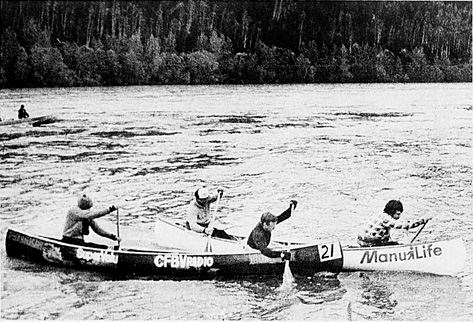Ten thousand paddle strokes in about four hours.
That's a rough estimate of what it will take for each paddler to travel 67.5 kilometres from Isle Pierre to Fort George Park in the Northern Hardware Prince George Centennial Canoe Race on Sunday, July 12.
To help commemorate the city's 100th birthday, the Two Rivers Canoe Club is reviving a race first launched in 1955.
"The race is to celebrate the 100th anniversary of Prince George but it's also to celebrate the First Nations," said race organizer Pat Turner. "This is their territory and their water and land that we're paddling through on a beautiful river. It's the route that Alexander Mackenzie and Simon Fraser paddled in the 1700s and 1800s."
Turner, who helped Canada win Olympic gold in the men's rowing eights at the 1984 Olympics in Los Angeles, says river racing is much different than the all-out sprint techniques that took him to the top of the world. The 67.5km Alexander Mackenzie route, most of which is on the Nechako River, is full of twists and turns which are rife with obstacles like overhanging trees and shallow sandbars. Paddlers will have to look for subtle differences on the water to recognize where the faster currents are.
There are at least two sections of rapids on the Mackenzie route - one at Isle Pierre and the other at Mud River (White Mud rapids) - which are ranked Class 2 and Class 3 (intermediate) on the international whitewater difficulty scale.
The original race, organized by the Northwest Brigade Canoe Club, started in Fort St. James and ended in Prince George. The route was shortened in 1960 to attract more participants. Because of the historical significance of the river and its role as a transportation route for explorers and fur traders traveling to and from the Hudson's Bay Company fort at Fort St. James, Turner has reached out to the Carrier-Sekani First Nation to encourage native people to participate.
"Paddling has a rich history in B.C. and we want to engage First Nations from around the province, primarily in this area," said Turner. "We know there are youth adventure and youth awareness groups that go out and use canoe paddling as a way of developing life skills."
The centennial race is attracting interest from paddlers in the three westernmost provinces and Washington state and organizers anticipate at least 30 boats. That list of entrants will include some familiar names, like Prince George Sports Hall of Fame member and four-time race winner Bruce Hawkenson, four-time champion Ron Williams of Smithers, and Harry James of Vernon, a two-time winner. This year's winners will receive a $2,500 cash prize,
"To have 30 or 40 boats, that would be a dream," said Turner. "A lot of people who have paddled that Northern Hardware race have come out of the woodwork. (For the Mackenzie route) you need to have some whitewater skills, plus the fitness of being able to paddle for four hours. We suspect the water flow will be low by July, based on where it is now. Wilkins Park is beyond the rapids.
"It's a very technique-oriented sport and you're (paddling) about 10,000 times in the long race, so you have to be efficient, and drafting is a huge part of it, like it is in cycling, but you have to know how to draft and where to sit to be efficient.
"There's a massive amount of strategy in knowing how to deal with currents, shallow or deep water and where to go on the river. Ron Williams has paddled for 50 years, marathon-style, and if you want to know where to go, follow Ron. He still competes at a high level because he's healthy and has such great strategy."
A shorter (Simon Fraser) route starts at Wilkins Park in Miworth and ends in Hudson's Bay Slough at Fort George Park. It's open to any type of paddled watercraft, including canoes, kayaks and standup paddle boards. All boats on the Mackenzie route must have two paddlers. At least two voyageur canoes which carry six to eight paddlers will be part of the longer race.
Spectators will have great vantage points from the three bridges over the Nechako and the Highway 16 bridge over the Fraser, as well as the city parks along the way. For the paddlers, the scenery will be non-stop.
"It's such an accessible piece of water and what impresses me about the river is how beautiful it is," said Turner. "Once you're out of the city it's brimming with wildlife. You get across to the other side of the river in these back bays and there's birds and beaver, eagles and moose, and you see wolf prints. It's a beautiful environment. We're really lucky to have it."
Northern Hardware is the major sponsor and Integris Credit Union is on board as well, supplying the food for the post-race picnic at Fort George Park. Turner is hoping city businesses or corporations will lend their names as sponsors with decals attached to the sides of individual boats.
For more information, go to the Two Rivers Canoe Club Facebook page or email Turner at [email protected]. Club members meet for practice sessions on the Nechako River at the Cottonwood Island boat launch on Tuesdays at 5:45 p.m.



